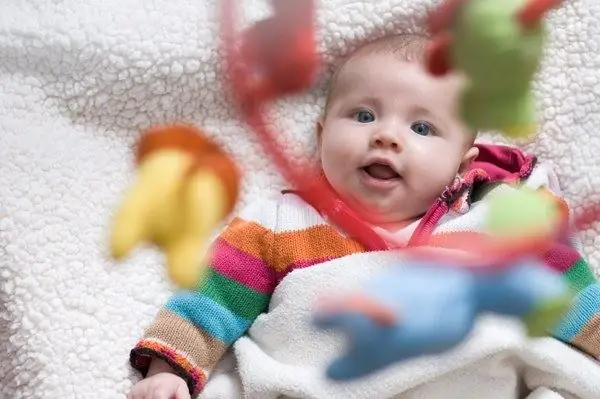- Author Horace Young [email protected].
- Public 2023-12-16 10:35.
- Last modified 2025-01-23 11:41.
The body of a newly born child does not have all the functions that an adult acquires over time. And the baby's vision is no exception, it also develops gradually, although the child begins to see from the moment he is born.

Vision plays a practically key role for a person in the study of the world. Thanks to vision, the child begins to perceive colors and shapes, the size of objects, and his brain develops significantly. The child is able to see unclearly from the moment of birth. The baby's vision develops gradually over the first 6-8 months of life, but even after that it does not stop developing.
The first months of life
Immediately after the birth of a child, blurred vision becomes a defensive reaction for him: the world is so big and huge, there are so many colors and objects in it that the child's psyche cannot yet withstand such a variety. Consequently, nature itself protects him from this. In the first month of life, the child still poorly distinguishes colors, sees objects vaguely, indistinctly. All that takes his attention is the face of his mother bending over him, and sometimes his father. The kid is able to distinguish objects at a distance of only 20-30 cm, which is just enough to see the person holding him in his arms. Therefore, it is very important for mothers during this period to maintain eye contact with the baby more often - he is not yet able to see anything else.
An interesting fact is that in the first one to two months after birth, the child still does not know how to look in only one direction. Therefore, his eyes may squint a little. There is nothing wrong with that, weak eye muscles do not allow the baby to focus on one object with two eyes at once. After the second month of life, this goes away in most children. In addition, his eyes have not yet lingered on any object for a long time. This ability will also appear in him by the third month of life.
Infants under three months old respond well to contrasting colors: black and white, light and dark, blue and yellow. In addition, it is best for them to choose solid colors rather than shades. So, they will catch white, red, blue, yellow colors better than pink, gray or orange. Toddlers love to look at colored pictures or objects, especially if they have a lot of colors and details. Therefore, at the age of two or three months, you need to give them rattles, show pictures, photographs, objects.
Age from 4 to 8 months
By about four months of age, the infant begins to develop depth of vision. This is what allows him to correctly assess at what distance the object is. Together with the development of vision, the baby also develops hand motor skills. He can already perfectly control them, grab objects and hold them. By the age of five months, the baby learns to distinguish between rather small objects and successfully observes their movement. Changes in vision continue: the child learns to distinguish tones and shades, he can distinguish outwardly similar colors.
By the age of eight months, a child's eyesight reaches the level of an adult. But still, for now, he sees much better than at a distance. At the same age, the color of the child's eyes is finally established. Finally, vision will be formed only by the age of 4, when the child can fully use the capabilities of his eyes, and his vision has not yet had time to deteriorate due to the heavy workload at school.






